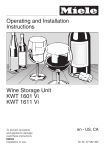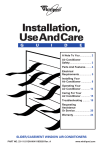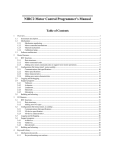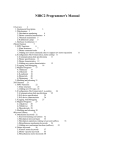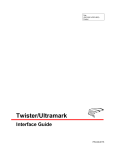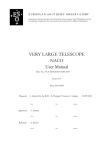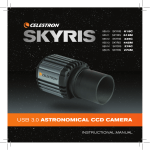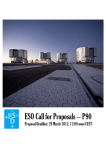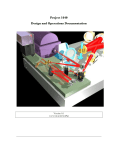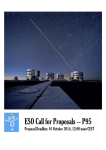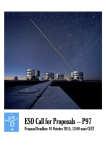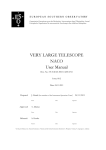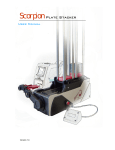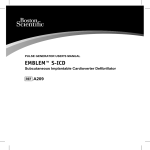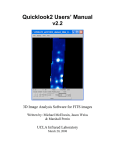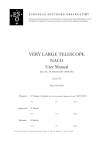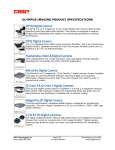Download - NIRC2 Software Functional Requirements
Transcript
Technical Specification NIRC2-98001 - Rev. 3 12/29/98 NIRC2 Software Functional Requirements A. Conrad, A. Honey, K. Matthews Distribution of this draft: NIRC2 bulletin board at http://www2.keck.hawaii.edu:3636/realpublic/inst/nirc2/ddoc/ software_des_req.pdf Table of Contents Index file /home/wea/nirc/software_des/current/software_des_req_rev3_cover.fm5 - printed December 29, NIRC2-98001 NIRC2 Software Functional Requirements Table of Contents 1 INTRODUCTION . . . . . . . . . . . . . . . . . . . . . . . . . . . . . . . . . . . . . . . . . . . . . . . . . . . . 1 1.1 Purpose and Scope . . . . . . . . . . . . . . . . . . . . . . . . . . . . . . . . . . . . . . . . . . . . . . . . . . . . 1 1.2 Acronyms . . . . . . . . . . . . . . . . . . . . . . . . . . . . . . . . . . . . . . . . . . . . . . . . . . . . . . . . . . . 1 1.3 Applicable Documents . . . . . . . . . . . . . . . . . . . . . . . . . . . . . . . . . . . . . . . . . . . . . . . . . 1 1.4 1.4.1 1.4.2 1.4.3 1.4.4 1.4.5 1.4.6 1.4.7 Instrument description . . . . . . . . . . . . . . . . . . . . . . . . . . . . . . . . . . . . . . . . . . . . . . . . . 1 Detector. . . . . . . . . . . . . . . . . . . . . . . . . . . . . . . . . . . . . . . . . . . . . . . . . . . . . . . . . . . . . 1 Imaging . . . . . . . . . . . . . . . . . . . . . . . . . . . . . . . . . . . . . . . . . . . . . . . . . . . . . . . . . . . . . 1 Spectroscopy . . . . . . . . . . . . . . . . . . . . . . . . . . . . . . . . . . . . . . . . . . . . . . . . . . . . . . . . . 1 Coronagraphy . . . . . . . . . . . . . . . . . . . . . . . . . . . . . . . . . . . . . . . . . . . . . . . . . . . . . . . . 1 Instrument Environment . . . . . . . . . . . . . . . . . . . . . . . . . . . . . . . . . . . . . . . . . . . . . . . . 2 Electronics and Computers . . . . . . . . . . . . . . . . . . . . . . . . . . . . . . . . . . . . . . . . . . . . . . 2 User . . . . . . . . . . . . . . . . . . . . . . . . . . . . . . . . . . . . . . . . . . . . . . . . . . . . . . . . . . . . . . . . 2 2 GENERAL DESIGN, QUALITY AND DOCUMENTATION REQUIREMENTS. . 3 2.1 Design . . . . . . . . . . . . . . . . . . . . . . . . . . . . . . . . . . . . . . . . . . . . . . . . . . . . . . . . . . . . . 3 2.2 Testability . . . . . . . . . . . . . . . . . . . . . . . . . . . . . . . . . . . . . . . . . . . . . . . . . . . . . . . . . . 3 2.3 Reliability . . . . . . . . . . . . . . . . . . . . . . . . . . . . . . . . . . . . . . . . . . . . . . . . . . . . . . . . . . . 3 2.4 Documentation . . . . . . . . . . . . . . . . . . . . . . . . . . . . . . . . . . . . . . . . . . . . . . . . . . . . . . . 3 3 TOP LEVEL FUNCTIONAL REQUIREMENTS. . . . . . . . . . . . . . . . . . . . . . . . . . . . 5 3.1 User - Observer . . . . . . . . . . . . . . . . . . . . . . . . . . . . . . . . . . . . . . . . . . . . . . . . . . . . . . 5 3.2 User - Instrument Specialist and Engineering . . . . . . . . . . . . . . . . . . . . . . . . . . . . . . . 5 3.3 Array readout . . . . . . . . . . . . . . . . . . . . . . . . . . . . . . . . . . . . . . . . . . . . . . . . . . . . . . . . 5 3.4 Data handling . . . . . . . . . . . . . . . . . . . . . . . . . . . . . . . . . . . . . . . . . . . . . . . . . . . . . . . 5 3.5 Software Operation . . . . . . . . . . . . . . . . . . . . . . . . . . . . . . . . . . . . . . . . . . . . . . . . . . . 6 4 USER . . . . . . . . . . . . . . . . . . . . . . . . . . . . . . . . . . . . . . . . . . . . . . . . . . . . . . . . . . . . . . 6 5 USER INTERFACE . . . . . . . . . . . . . . . . . . . . . . . . . . . . . . . . . . . . . . . . . . . . . . . . . . . 7 5.1 User Command Input . . . . . . . . . . . . . . . . . . . . . . . . . . . . . . . . . . . . . . . . . . . . . . . . . . 7 5.2 5.2.2 5.2.3 5.2.4 User display of system parameters . . . . . . . . . . . . . . . . . . . . . . . . . . . . . . . . . . . . . . . 7 Text clarity . . . . . . . . . . . . . . . . . . . . . . . . . . . . . . . . . . . . . . . . . . . . . . . . . . . . . . . . . . 7 Display Organization . . . . . . . . . . . . . . . . . . . . . . . . . . . . . . . . . . . . . . . . . . . . . . . . . . 8 Display content . . . . . . . . . . . . . . . . . . . . . . . . . . . . . . . . . . . . . . . . . . . . . . . . . . . . . . . 8 5.3 5.3.1 5.3.2 User image display and manipulation . . . . . . . . . . . . . . . . . . . . . . . . . . . . . . . . . . . . . 8 Image display . . . . . . . . . . . . . . . . . . . . . . . . . . . . . . . . . . . . . . . . . . . . . . . . . . . . . . . . 8 Image arithmetic commands . . . . . . . . . . . . . . . . . . . . . . . . . . . . . . . . . . . . . . . . . . . . . 9 page 1 of 3 NIRC2-98001 6 USER COMMANDS . . . . . . . . . . . . . . . . . . . . . . . . . . . . . . . . . . . . . . . . . . . . . . . . . 10 6.1 6.1.1 6.1.2 6.1.3 6.1.4 6.1.5 6.1.6 6.1.7 6.1.8 6.1.9 6.1.10 6.1.11 6.1.12 6.1.13 6.1.14 6.1.15 Observer Commands . . . . . . . . . . . . . . . . . . . . . . . . . . . . . . . . . . . . . . . . . . . . . . . . . 10 Detector Array Commands . . . . . . . . . . . . . . . . . . . . . . . . . . . . . . . . . . . . . . . . . . . . . 10 Housekeeping Data Acquisition Commands . . . . . . . . . . . . . . . . . . . . . . . . . . . . . . . 10 Filter Wheel Commands . . . . . . . . . . . . . . . . . . . . . . . . . . . . . . . . . . . . . . . . . . . . . . . 11 Camera Commands. . . . . . . . . . . . . . . . . . . . . . . . . . . . . . . . . . . . . . . . . . . . . . . . . . . 11 Grism Slide Commands . . . . . . . . . . . . . . . . . . . . . . . . . . . . . . . . . . . . . . . . . . . . . . . 11 Slit Commands . . . . . . . . . . . . . . . . . . . . . . . . . . . . . . . . . . . . . . . . . . . . . . . . . . . . . . 12 Pupil Mask Commands . . . . . . . . . . . . . . . . . . . . . . . . . . . . . . . . . . . . . . . . . . . . . . . . 12 Preslit Commands . . . . . . . . . . . . . . . . . . . . . . . . . . . . . . . . . . . . . . . . . . . . . . . . . . . . 12 Coronagraph Commands . . . . . . . . . . . . . . . . . . . . . . . . . . . . . . . . . . . . . . . . . . . . . . 13 Calibration Lamp Commands (Local and AO). . . . . . . . . . . . . . . . . . . . . . . . . . . . . . 13 Telescope Commands . . . . . . . . . . . . . . . . . . . . . . . . . . . . . . . . . . . . . . . . . . . . . . . . . 13 Hybrid (telescope/instrument) Commands . . . . . . . . . . . . . . . . . . . . . . . . . . . . . . . . . 14 Data Storage Commands. . . . . . . . . . . . . . . . . . . . . . . . . . . . . . . . . . . . . . . . . . . . . . . 14 Internal Commands. . . . . . . . . . . . . . . . . . . . . . . . . . . . . . . . . . . . . . . . . . . . . . . . . . . 15 Miscellaneous Commands . . . . . . . . . . . . . . . . . . . . . . . . . . . . . . . . . . . . . . . . . . . . . 15 6.2 6.2.1 6.2.2 Maintenance Commands . . . . . . . . . . . . . . . . . . . . . . . . . . . . . . . . . . . . . . . . . . . . . . 15 Mechanism Commands. . . . . . . . . . . . . . . . . . . . . . . . . . . . . . . . . . . . . . . . . . . . . . . . 15 Array Voltage Commands . . . . . . . . . . . . . . . . . . . . . . . . . . . . . . . . . . . . . . . . . . . . . 15 6.3 6.3.1 6.3.2 6.3.3 6.3.4 6.3.5 6.3.6 6.3.7 6.3.8 Engineering Commands . . . . . . . . . . . . . . . . . . . . . . . . . . . . . . . . . . . . . . . . . . . . . . . 16 Motor Commands . . . . . . . . . . . . . . . . . . . . . . . . . . . . . . . . . . . . . . . . . . . . . . . . . . . . 16 Reserved . . . . . . . . . . . . . . . . . . . . . . . . . . . . . . . . . . . . . . . . . . . . . . . . . . . . . . . . . . . 16 Temperature Controller Commands . . . . . . . . . . . . . . . . . . . . . . . . . . . . . . . . . . . . . . 16 Coldhead Speed Control Commands . . . . . . . . . . . . . . . . . . . . . . . . . . . . . . . . . . . . . 16 Lamp controller commands . . . . . . . . . . . . . . . . . . . . . . . . . . . . . . . . . . . . . . . . . . . . 16 Read of Parameters . . . . . . . . . . . . . . . . . . . . . . . . . . . . . . . . . . . . . . . . . . . . . . . . . . . 16 Write to Selected Variables . . . . . . . . . . . . . . . . . . . . . . . . . . . . . . . . . . . . . . . . . . . . 17 Target commands . . . . . . . . . . . . . . . . . . . . . . . . . . . . . . . . . . . . . . . . . . . . . . . . . . . . 17 6.4 Command and Language Characteristics . . . . . . . . . . . . . . . . . . . . . . . . . . . . . . . . . . 17 7 HARDWARE-SOFTWARE REQUIREMENTS . . . . . . . . . . . . . . . . . . . . . . . . . . . 18 7.1 General Requirements . . . . . . . . . . . . . . . . . . . . . . . . . . . . . . . . . . . . . . . . . . . . . . . . 18 7.2 7.2.1 7.2.2 7.2.3 Instrument Mechanism Motor Control . . . . . . . . . . . . . . . . . . . . . . . . . . . . . . . . . . . 18 Programming. . . . . . . . . . . . . . . . . . . . . . . . . . . . . . . . . . . . . . . . . . . . . . . . . . . . . . . . 18 Homing . . . . . . . . . . . . . . . . . . . . . . . . . . . . . . . . . . . . . . . . . . . . . . . . . . . . . . . . . . . . 18 Movement . . . . . . . . . . . . . . . . . . . . . . . . . . . . . . . . . . . . . . . . . . . . . . . . . . . . . . . . . . 19 7.3 7.3.1 7.3.2 7.3.3 7.3.4 7.3.5 Cold Head Motors . . . . . . . . . . . . . . . . . . . . . . . . . . . . . . . . . . . . . . . . . . . . . . . . . . . 19 General Considerations. . . . . . . . . . . . . . . . . . . . . . . . . . . . . . . . . . . . . . . . . . . . . . . . 19 Programming. . . . . . . . . . . . . . . . . . . . . . . . . . . . . . . . . . . . . . . . . . . . . . . . . . . . . . . . 20 Initiating Computer control. . . . . . . . . . . . . . . . . . . . . . . . . . . . . . . . . . . . . . . . . . . . . 20 Setting motor parameters . . . . . . . . . . . . . . . . . . . . . . . . . . . . . . . . . . . . . . . . . . . . . . 20 Sensing motor condition . . . . . . . . . . . . . . . . . . . . . . . . . . . . . . . . . . . . . . . . . . . . . . . 20 page 2 of 3 NIRC2-98001 7.4 7.4.1 7.4.2 Spectral Lamps . . . . . . . . . . . . . . . . . . . . . . . . . . . . . . . . . . . . . . . . . . . . . . . . . . . . . . 20 General considerations . . . . . . . . . . . . . . . . . . . . . . . . . . . . . . . . . . . . . . . . . . . . . . . . 20 Programing . . . . . . . . . . . . . . . . . . . . . . . . . . . . . . . . . . . . . . . . . . . . . . . . . . . . . . . . . 21 7.5 7.5.1 7.5.2 7.5.3 7.5.4 7.5.5 7.5.6 7.5.7 7.5.8 Temperature Control and Monitoring . . . . . . . . . . . . . . . . . . . . . . . . . . . . . . . . . . . . 21 General . . . . . . . . . . . . . . . . . . . . . . . . . . . . . . . . . . . . . . . . . . . . . . . . . . . . . . . . . . . . 21 Programing . . . . . . . . . . . . . . . . . . . . . . . . . . . . . . . . . . . . . . . . . . . . . . . . . . . . . . . . . 21 Temperature and Heater Monitoring . . . . . . . . . . . . . . . . . . . . . . . . . . . . . . . . . . . . . 22 Detector Temperature Control. . . . . . . . . . . . . . . . . . . . . . . . . . . . . . . . . . . . . . . . . . . 22 Optical Bench Temperature Control. . . . . . . . . . . . . . . . . . . . . . . . . . . . . . . . . . . . . . 22 Radiation Shield Temperature Control. . . . . . . . . . . . . . . . . . . . . . . . . . . . . . . . . . . . 22 Cool Down . . . . . . . . . . . . . . . . . . . . . . . . . . . . . . . . . . . . . . . . . . . . . . . . . . . . . . . . . 22 Warm Up and Baking . . . . . . . . . . . . . . . . . . . . . . . . . . . . . . . . . . . . . . . . . . . . . . . . . 22 7.6 Array Electronics . . . . . . . . . . . . . . . . . . . . . . . . . . . . . . . . . . . . . . . . . . . . . . . . . . . . 22 Appendix A: Image Headers . . . . . . . . . . . . . . . . . . . . . . . . . . . . . . . . . . . . . . . . . . . . . . . . . . . 23 page 3 of 3 NIRC2-98001 1 INTRODUCTION 1.1 Purpose and Scope This document identifies the requirements on software to second generation Near InfraRed Camera (NIRC2) for the Keck II Telescope. 1.2 Acronyms ADU AO FITS NIRSPEC ... Analog Data Unit Adaptive Optics system of the Keck II Telescope Flexible Image Transport System Near InfraRed Spectrometer 1.3 Applicable Documents 1.4 Instrument description NIRC2 is a diffraction limited, imaging spectrograph, to be used in conjunction with the adaptive optics (AO) system on the Keck II Telescope. 1.4.1 Detector NIRC2 uses a single 1024 by 1024 pixel InSb detector, which has 32 parallel outputs, 8 for each of the 4 independent quadrants of the multiplexer. The readout electronics is a duplicate of that built for NIRSPEC, modified to provide capability for subframing with the restriction that the same readout pattern is used on each quadrant of the detector. 1.4.2 Imaging NIRC2 has three selectable cameras, each with a different plate scale (.01, .02 and .04 arcsec per pixel), two filter wheels and a wheel containing selectable pupil masks that can be driven to follow the rotation of the hexagonal telescope pupil. These are in series in the collimated portion of the optical path. Polarizing prisms may be installed in the filter wheels in the future. 1.4.3 Spectroscopy For spectroscopy, NIRC2 has up to five grisms on a movable stage and two stages that are used to position slits and slit masks. In addition to the slits it has a preslit consisting of two movable masks used to baffle the spectrograph. Grisms may also be installed in the filter wheels in the future. There are spectral calibration lamps for NIRC2 mounted on the AO system. 1.4.4 Coronagraphy Besides carrying slits, the slit stage will carry occulting masks to be used with the pupil masks to give the camera mode a coronagraphic capability. page 1 of 25 NIRC2-98001 1.4.5 Instrument Environment Temperatures in the instrument are monitored and controlled by cryogenic temperature controllers mounted near the instrument. The speeds of the cold head motors are controlled by variable frequency controllers located in the machinery room in the observatory building. 1.4.6 Electronics and Computers The readout electronics are located near the instrument vacuum case, and are connected to the dedicated target and host computers in the computer room, which is also on top of Mauna Kea. This connection is by optical fiber. The host is also network-connected to the telescope control system for the purpose of sending commands and receiving telescope and adaptive optics system information. 1.4.7 User The users (observer, instrument specialist, or engineer) may connect to the host from any location using a remote computer networked to the host. page 2 of 25 NIRC2-98001 2 GENERAL DESIGN, QUALITY AND DOCUMENTATION REQUIREMENTS 2.1 Design 2.1.1 The design shall be modular. Each module shall be as self contained as possible, with a well defined interface to the other modules. 2.1.2 The design shall have a rational organization so that it can be comprehended by others and by the original programmers after the fact. 2.1.3 Appropriate attention shall be given to the fact that the code might need to be modifications or extended in the future. 2.1.4 Appropriate attention shall be given to the fact that the code might need to be ported to another machine or that an operating system upgrade might be desired. 2.1.5 The code shall be appropriately fast. The user should not be bothered by unnecessary delays, but the code should not be made complicated to achieve unneeded speed. 2.2 Testability 2.2.1 Modules shall be, as much as possible, testable as stand-alone pieces. 2.2.2 Dummy modules shall be available where necessary. 2.2.3 Emulation programs shall be supplied for use in place of external interfaces. 2.3 Reliability 2.3.1 The software shall be written with reliability in mind. 2.3.2 Exceptions and errors shall be handled in a way that prevents failure. 2.3.3 Time-outs shall be used with all external interfaces to prevent the software from hanging. 2.3.4 Memory shall be properly managed; for instance, leaks shall be well controlled. 2.3.5 Testing shall be intensive and extensive. It shall be very thorough over the most commonly used range of operating modes while also sampling the boundaries of the operation space. 2.3.6 The hardware response to the software shall be thoroughly tested. 2.4 Documentation 2.4.1 An installation guide. 2.4.2 A programming guide for the command language. 2.4.3 A user manual describing the functionality for the user. page 3 of 25 NIRC2-98001 2.4.4 An engineering user supplement describing engineering commands and hardware interfaces. 2.4.5 A description of the functionality of the software and its relationship to the hardware. 2.4.6 A detailed description of the structure of the software. 2.4.7 A detailed description of the interaction of any module with other modules. 2.4.8 Each module shall have a title, a header listing all inputs and outputs, and data structures that mention how these items are modified. A description of what the module does, and a description or reference to any algorithms executed by the module shall be given. If the module interfaces with hardware, there shall be a reference to the appropriate hardware manual. 2.4.9 Additional Documents per KSD-3 In addition, the delivered system shall include the following documentation as specified in the Keck Software Document “Software Items for the Acceptance Review” (KSD-3). 2.4.9.1 User's Manual (same as 2.4.1). 2.4.9.2 As-Built CDR Documents. 2.4.9.3 Source Code List. 2.4.9.4 Function Descriptions. 2.4.9.5 Start-up / Shutdown Procedures. 2.4.9.6 Installation Manual. 2.4.9.7 Troubleshooting Guide. 2.4.9.8 Programmer's manual. page 4 of 25 NIRC2-98001 3 TOP LEVEL FUNCTIONAL REQUIREMENTS 3.1 User - Observer 3.1.1 Can operate from a remote site if desired. 3.1.2 Can easily determine the configuration of the instrument. 3.1.3 Can configure the instrument for data collection. 3.1.4 Can initiate data collection and abort it if so desired. 3.1.5 Has the ability to inspect images as they arrive and do a limited number of quick look arithmetic operations on them. This requirement can be relaxed because of data throughput limitations. 3.1.6 Can send commands to the telescope which includes the AO system. 3.1.7 Can enter a sequence of commands before execution. 3.1.8 Can produce scripts and procedures embodying the above functions. 3.1.9 Has access to an on-line help facility. 3.2 User - Instrument Specialist and Engineering 3.2.1 Has all of the abilities of the Observer. 3.2.2 Has the ability to temporarily or permanently change any of the parameters of the instrument. For example, filter names and wavelengths, slit parameters, optical parameters, thermal parameters, array parameters etc. 3.2.3 Has access to low level engineering functions, for example, primitive motor commands, limit changes, electronic test functions. 3.2.4 Is given the maximum flexibility without recompilation of software. 3.3 Array readout 3.3.1 Setup the array operating parameters. 3.3.2 Read out the array in various modes, full frame and subframe 3.3.3 Time stamp the sequence of images. 3.4 3.4.1 Data handling Data shall be stored on disk in FITS format with a keyword header giving parameters of the exposure listed in Appendix A, including an accurate time stamp. Sequences of single or multiple full or subframe images shall be saved to disk at the maximum rate supported by the UCLA software, with a sequence length limited only by storage medium size. page 5 of 25 NIRC2-98001 3.4.2 There shall be fast buffers for the data and their headers for quick display. 3.4.3 Data shall be accessible over the net for other uses without impacting instrument operation. 3.4.4 Housekeeping data shall be archived at a low rate. 3.4.5 The command sequence to the host shall be archived. 3.4.6 As much as possible, errors and exceptions shall be archived. 3.5 Software Operation 3.5.1 Start-up shall require a minimum of commands; ideally one. 3.5.2 Start-up shall not depend on the previous state of the system. 3.5.3 Shutdown shall leave the system in a cleaned up state. 3.5.4 The state of the instrument shall be saved to allow restart in the same configuration, as much as is sensible, in case of a failure. 3.5.5 The software shall be robust and reliable. A user should not be able to break it and it should run for weeks without failure. 3.5.6 The software shall protect itself against failures caused by interactions with systems outside of itself, for instance, instrument, user or telescope communications. 4 USER 4.1 Logon from remote network-connected computers. 4.2 Security such as a password. 4.3 Several levels of user with nested subsets of capability to interact with the software. Observer, Instrument Specialist, and Engineer in order of capabilities. 4.4 High level users can preempt lower level users. 4.5 A user can be logged on multiple times so that non-blocked commands such as image display or manipulation can be executed in parallel with data acquisition. page 6 of 25 NIRC2-98001 5 USER INTERFACE 5.1 User Command Input 5.1.1 All commands shall be executable by typing at a command line interface. 5.1.2 Commands can be combined on a line but not executed until a carriage return is typed. 5.1.3 The commands shall be part of a command scripting language, in which command sequences can be created and stored as text files. 5.1.4 The editing functions shall include at least insertion, deletion, rearrangement and duplication. The arrow keys should operate in tcsh fashion. 5.1.5 It is desirable that the user be able to test a command file by use of some sort of previewer. 5.1.6 The design shall facilitate the future addition of a graphical user interface (GUI) for the entering of commands. These commands shall act the same way as typed-in commands. 5.2 User display of system parameters 5.2.1 5.2.2 System parameters shall be clearly and unambiguously displayed. Text clarity 5.2.2.1 The most readable font shall be used. 5.2.2.2 Only one font shall be used unless there is a compelling reason to do otherwise. Italic and bold fonts may be used for user warnings and alarm notification if their use results in improved clarity. 5.2.2.3 The text shall be readable by someone with 20/20 vision at six feet. 5.2.2.4 Text size shall not vary significantly. 5.2.2.5 A visual alarm mechanism, such as reverse video or flashing display, shall be provided. 5.2.2.6 Obvious, redundant, or superfluous information shall not be displayed. 5.2.2.7 Color shall not be the sole method of imparting information. 5.2.2.8 Text shall tend to fill the space. Wide borders, etc. shall not be used. 5.2.2.9 Display shall be in specified SI units and units shall not be changed unless clarity is improved. 5.2.2.10 Numerical display shall be in integer for integer parameters. 5.2.2.11 Numerical display shall be in fixed point for real parameters and only be displayed to page 7 of 25 NIRC2-98001 a significance appropriate to the uncertainty of the parameter. Exponential notation is discouraged. 5.2.2.12 5.2.3 Integer displays shall never be truncated. Fixed point and alpha displays may be truncated on the right. Exponential notation may never be truncated. Display Organization 5.2.3.1 A primary display with the fundamental parameters for observing shall always be available and immutable in format. It shall contain parameters such as integration time, filter name, grism, camera, etc. 5.2.3.2 Less-used parameters shall be placed in secondary displays. They should be organized by function and need not always be present. Provision of a user-configurable display of information is desirable but not required. 5.2.3.3 Access to displays shall be by command but may also be by a GUI mechanism such as a pull down menu. 5.2.3.4 A countdown time to the end of the current exposure shall always be displayed. This can be a time bar with time of completion and time of start also displayed as text. 5.2.3.5 A graphical display for overall instrument configuration with pull out menus of functions would be desirable. 5.2.4 Display content 5.2.4.1 Displays shall show ACTUAL parameters in a timely fashion. User input should not be just displayed but, for instance, motor positions should be read back from the controller and the positions verified. 5.2.4.2 If a parameter is unknown or out of range it shall be indicated. (For example, ???? for unknown and ***** for out of range.) 5.3 User image display and manipulation The NIRC2 image display functions will be provided through the UCLA-furnished IDL display package. 5.3.1 5.3.1.1 Image display The image display shall provide the following functionality: • • • • Zoom: 2D in/out, 1D in/out, and go to normal zoom. Pan the image via the mouse drag function. Recenter image. Provide a small display of the full image that indicates the zoomed-in location of the main window. • Color map adjustment (also known as contrast adjustment). • Show a window that depicts the color map as an RGB graph and/or a color bar. • Rescale ADU to histogram equalization, autodisp, or linear. page 8 of 25 NIRC2-98001 • Line Graphics: X-Y plot of pixel values lying below a rubber band line drawn with the mouse. • Produce a column plot in the line graphics window of the column clicked on. • Produce a row plot in the line graphics window of the row clicked on. • Decrease or increase the number of pixels averaged for a line plot. • Statistics: Within a box specified via the mouse, report mean, sigma, min, max, X range, Y range, total pixels, and x,y of max. • Mouse over reports X, Y, and ADU. • Print the entire image. • Toggle color map inversion. • Report the centroid and the FWHM of the image. • Display help text. • Report all values in reasonable precision and avoid floating point notation. • Label the grid ticks on line graphics at reasonable intervals. 5.3.2 Image arithmetic commands Commands shall be provided to perform the following arithmetic operations on images: 5.3.2.1 Move images between storage and memory buffers. 5.3.2.2 Do arithmetic between images and images and constants, variables or functions. 5.3.2.3 Reserved. 5.3.2.4 Find the average, sum, median, mode, and rms fluctuation from the mean of a rectangular region. 5.3.2.5 Find the average, sum, median, mode, and rms fluctuation from the mean of an annular region and a circular region. 5.3.2.6 Find the centroid of intensity in a circular region of an image. 5.3.2.7 Reserved. 5.3.2.8 Find the parameters of the best-fit circular Gaussian centered on a specified position. 5.3.2.9 Find the parameters of the best-fit elliptical Gaussian centered on a specified position. page 9 of 25 NIRC2-98001 6 USER COMMANDS 6.1 Observer Commands 6.1.1 Detector Array Commands Commands for the detector array shall be implemented through UCLA-provided software (similar to NIRSPEC, but modified to provide subframing capability). See document no. TBD. Array commands which are not already predefined in the UCLA software are implemented in the NIRC2 software through the UCLA keyword library. To the extent supported by the UCLA software, commands for the following functions shall be provided. 6.1.1.1 Data Acquisition Commands 6.1.1.1.1 Start a sequence of exposures that will be handled until done by the host in a deterministically timed fashion, and be stored with FITS header. 6.1.1.1.2 Start a sequence as in 6.1.1.1.1 but query for object name and type and give informative warnings. 6.1.1.1.3 Abort an ongoing sequence of exposures without saving anything and do not advance the run number. 6.1.1.2 Target Configuration Commands 6.1.1.2.1 Load a target array readout program by name if there is more than one. This would include clocks, biases, timing patterns etc. 6.1.1.2.2 Assign the number of the next data file to be written. 6.1.1.2.3 Select a readout mode: • • • • 6.1.1.2.4 Change of parameters associated with the readout mode: • • • • • 6.1.2 Fowler mode with global reset. Read mode with pair reset after n read. Read mode with global reset after n full frame read. Others TBD. Detector bias. Frame integration time. Number of frames coadded to a picture. Start and end of subframe in x and y. Number of reads, if Fowler, number of nondestructive reads at each end. Housekeeping Data Acquisition Commands 6.1.2.1 Get the instrument temperatures and heater powers and display them. 6.1.2.2 Get the cold head motor physical parameters and display them. 6.1.2.3 Get the current positions of the motor driven mechanisms and display them. For those page 10 of 25 NIRC2-98001 mechanisms with discrete positions, the displayed positions must include the name of the position, the position number, and the target position name and number when in transit. For all mechanisms, the display must include the state of the mechanism (e.g. moving or idle), the absolute position in engineering units (e.g. angular position in degrees or displacement in millimeters), and the position in motor units. 6.1.3 Filter Wheel Commands 6.1.3.1 A named procedure that configures the two filter wheels, grism slide, slits and preslits for a “filter”. It shall also set the header for the configuration name. This is for imaging with and without the coronagraph. A dark command shall also be included. 6.1.3.2 Blocker command that moves one filter wheel and does not move anything else. 6.1.3.3 Grism command that puts in a filter-wheel-based grism of n grooves/mm. 6.1.3.4 Grism procedure with filter name and grism of n grooves/mm that puts in that filter and grism and clears the grism slide. 6.1.3.5 Other named commands, such as those for a polarizing prism. 6.1.3.6 A home command to locate a 'home' position which will be regarded as the filter wheel's absolute zero position. 6.1.3.7 Motion commands to move the filter wheels by filter name, by discrete numbered position, by absolute angular position in degrees from its home position, by absolute motor counts, and by offsets in motor units. 6.1.4 Camera Commands 6.1.4.1 Insert a camera of a given scale. 6.1.4.2 A home command to locate a 'home' position which will be regarded as the camera slide's absolute zero position. 6.1.4.3 Motion commands to move the camera stage by camera name, to discrete numbered position, by displacement from its home position, by absolute motor units, and by offsets in motor units. 6.1.5 Grism Slide Commands 6.1.5.1 Insert grism of a given groove spacing. 6.1.5.2 Insert pupil mask imager if on stage. 6.1.5.3 Clear grisms and pupil mask imager 6.1.5.4 A procedure that inserts a given grism and its order sorting filter. 6.1.5.5 A procedure that inserts a given grism, its order sorting filter, grism cross-disperser in a filter wheel and decker mask. 6.1.5.6 A home command to locate a 'home' position which will be regarded as the grism page 11 of 25 NIRC2-98001 slide's absolute zero position. 6.1.5.7 6.1.6 Motion commands to move the grism slide by grism name, by discrete numbered position, by displacement from its home position, in absolute motor units, and by offsets in motor units. Slit Commands 6.1.6.1 Insert a slit of given width with appropriate slit mask at position y. 6.1.6.2 Insert a slit of given width with appropriate slit mask of given length x (used as a decker for echelle) at position y. 6.1.6.3 Clear the slits and mask. 6.1.6.4 Close the slits and mask to block all light. 6.1.6.5 A home command to locate a 'home' position which will be regarded as the slit's or slit mask's absolute zero position. 6.1.6.6 Motion commands to move the slit or slit mask by name, by discrete numbered position, by displacement from a home position, by absolute motor units, and by offsets in motor units. 6.1.7 Pupil Mask Commands 6.1.7.1 Insert the circumscribed circular pupil mask. 6.1.7.2 Insert the inscribed circular pupil mask. 6.1.7.3 Insert one of the hexagonal masks, adjust to match telescope pupil orientation, and follow the pupil rotation. 6.1.7.4 Insert square pupil mask. 6.1.7.5 A home command to locate a 'home' position which will be regarded as the pupil mask's or pupil rotation drives's absolute zero position. 6.1.7.6 Motion commands to move the pupil mask by name, by discrete numbered position, by displacement from a home position, by absolute motor counts, and by offsets in motor counts. 6.1.7.7 Motion commands to move the pupil rotation drive to absolute angular positions, in absolute motor units, and by offsets in motor units. 6.1.8 Preslit Commands 6.1.8.1 Set preslits to follow the slits if they are in or act as a baffle if in imaging mode. 6.1.8.2 Clear the preslits. 6.1.8.3 A home command to locate a 'home' position which will be regarded as the preslits' absolute zero position. page 12 of 25 NIRC2-98001 6.1.8.4 6.1.9 Motion commands to move the preslits by aperture or edge name, by discrete numbered position, by displacement from a home position, by absolute motor units, and by offsets motor units. Coronagraph Commands 6.1.9.1 Insert a given diameter coronagraph mask at position y. 6.1.9.2 Clear the coronagraph masks (same as clearing the slits.) 6.1.10 Calibration Lamp Commands (Local and AO) 6.1.10.1 Position a lamp at a y value in the focal plane. 6.1.10.2 Position a lamp at the current slit position. 6.1.10.3 Turn on or off a specified lamp. 6.1.10.4 Turn off all lamps. 6.1.10.5 Turn off all lamps and return them to their stowed position. 6.1.11 Telescope Commands These commands are controlled by other (non-NIRC2) software, implemented through NIRC2 commands. NIRC2 software expects acknowledgment of receipt and completion 6.1.11.1 Move the telescope a distance in sky coordinates. 6.1.11.2 Move the telescope a distance in elevation and azimuth. 6.1.11.3 Move the telescope a distance in NIRC2 entrance focal plane coordinates 6.1.11.4 Move the telescope to a position on the detector focal plane in pixels. 6.1.11.5 Move the telescope by the vector between two cursors positions. 6.1.11.6 Set the focus of the telescope to a position. 6.1.11.7 Increment the focus of the telescope. 6.1.11.8 Request a move of the telescope to a coordinate in a given equinox with given proper motion. 6.1.11.9 Request a move of the telescope to an entry on an object list. 6.1.11.10 Get the telescope coordinates, airmass, times, parallactic angle. 6.1.11.11 Get meteorological information and temperatures. 6.1.11.12 Go to a given AO mode. (Laser guide star, Natural guide star, flattened mirror, simulator, etc.) 6.1.11.13 Track on sky with Y axis at a given position angle on the sky. (Command is restricted by mode used.) page 13 of 25 NIRC2-98001 6.1.11.14 Track on sky with Y axis at a given position angle the section of the great circle going from the pointing axis to the zenith (fix in telescope pupil space). (Command is restricted by mode used.) 6.1.11.15 Calibration lamp commands (See 6.1.10). These require that the stage on the AO bench be moved to a position and also that the K-mirror be set to a specific angle. 6.1.11.16 Send image parameter (e.g., object brightness, image quality, loss of track) that determines when the AO should signal a shutter open or close. The AO signal to NIRC2 (returned via mechanism control keyword, section XXX below) must have latency of less than 100 msec. 6.1.11.17 Send tip-tilt star parameters to AO. 6.1.11.18 Center a target in the NIRC2 detector, given its current (x,y) pixel coordinates. 6.1.11.19 Center a target on the NIRC2 slit, given its current (x,y) pixel coordinates. 6.1.11.20 Move a target along the length of the slit. 6.1.11.21 Return the telescope to its “zero” position. 6.1.11.22 Load the current telescope offset position into variables, and restore the telescope to this loaded position. 6.1.12 Hybrid (telescope/instrument) Commands 6.1.12.1 Dither patterns, which will combine telescope offsets with NIRC2 images and possibly image display. For spectroscopy, this will include dithering along the slit. 6.1.12.2 A simple “image-telescope offset-image-return” sequence with optional image display. 6.1.12.3 Focusing tools. This would include the standard “MAlign” technique for focusing and tilting the Keck secondary and restacking the mirror segments. It would also include taking a series of images at different secondary focus positions and allowing the observer to estimate a “best focus position” from the subsequent image quality. 6.1.13 Data Storage Commands 6.1.13.1 Get the directory information of the file space. 6.1.13.2 Display available free disk space. 6.1.13.3 Write a data buffer to a file with a modified FITS header. 6.1.13.4 Copy a file to another file. 6.1.13.5 Rename a file. 6.1.13.6 Delete a file. page 14 of 25 NIRC2-98001 6.1.14 Internal Commands 6.1.14.1 A sleep command that halts the execution of the command sequence for a specified number of seconds. This command should be aborted by a continue command. 6.1.14.2 A pause command that halts the command sequence until a continue command restarts the flow. It would be desirable if the amount of time the pause was held was displayed. 6.1.14.3 A wait-till-a-time command. This command should be aborted by a continue command. 6.1.15 Miscellaneous Commands 6.1.15.1 Enter the names of the observers. 6.1.15.2 Enter the object name and type. 6.1.15.3 Enter and edit comments. 6.1.15.4 Create and execute a command script. 6.2 Maintenance Commands Maintenance commands are those which an instrument specialist might utilize to diagnose problems, but would rarely, if ever, be used by observers. 6.2.1 Mechanism Commands Mechanisms are those specified in sections 6.1.3 through 6.1.10 6.2.1.1 A halt command for each of the motor driven mechanisms. 6.2.1.2 Enable and disable a mechanism's servo. 6.2.1.3 Set and release a mechanisms's brakes. 6.2.1.4 Reset a mechanism's motor controller. 6.2.1.5 Determine whether or not a mechanism's motor is idle. 6.2.1.6 Determine whether or not a mechanism's motor has successfully homed. 6.2.1.7 Display the information relevant to a mechanism. An example would be a mechanism with discrete positions whose display would include position numbers, names, and absolute positions. 6.2.2 Array Voltage Commands 6.2.2.1 Set the detector bias voltage. 6.2.2.2 Set the preamplifier offset voltages for each detector quadrant independently. 6.2.2.3 Globally set the preamplifier offset voltages. page 15 of 25 NIRC2-98001 6.3 Engineering Commands Engineering commands are commands which are needed for: configuring of controllers and device modules; integration; and trouble-shooting. 6.3.1 Motor Commands These motor commands are low-level, referring to each individual motor rather than mechanisms (where mechanisms are those discussed in sections 6.1.3 through 6.1.10). 6.3.1.1 Home, reset, stop motion, enable and disable servos, set and release brakes, and commence motion to a specified motor position in absolute or relative terms. 6.3.1.2 Obtain any status value that is supplied by the motor controller's command set. 6.3.1.3 Issue any command provided by the motor controller's command set. 6.3.2 Reserved 6.3.3 Temperature Controller Commands 6.3.3.1 Read the current value of any of the temperature sensors. 6.3.3.2 Enable and disable temperature control. 6.3.3.3 Set detector block temperature. 6.3.3.4 Set the optical bench temperature. 6.3.3.5 Issue any command provided by the temperature controller's command set. 6.3.4 Coldhead Speed Control Commands 6.3.4.1 Set either of the continuously adjustable coldhead speeds independently (or currents, as determined by a hardware jumper). 6.3.4.2 Read either coldhead speed. 6.3.4.3 Turn either coldhead on or off independently. 6.3.4.4 Set the hardware controller to either computer control or manual mode. 6.3.4.5 Issue any command provided by the coldhead controller's command set. 6.3.5 Lamp controller commands 6.3.5.1 Move the lamps to a specified position in mm (independent of K-mirror motion). 6.3.5.2 Issue any command provided by the lamp controller's command set. 6.3.6 6.3.6.1 Read of Parameters Read the motor controller and thermal devices' control parameters. page 16 of 25 NIRC2-98001 6.3.7 Write to Selected Variables 6.3.7.1 6.3.8 Set any of the motor controller and thermal devices' control parameters, and a mechanism for making updates permanent between observing runs. Target commands TBD. 6.4 Command and Language Characteristics 6.4.1 The language shall have read access to the parameters of the instrument and write access to as large a set as is sensible. 6.4.2 In general, commands shall not query for user input. If a command does, there shall be an alternate form that can get the input from variables 6.4.3 Commands shall put any output into variables (not supported by UCLA software). 6.4.4 Where appropriate there shall be a command form that also displays the output to the user. page 17 of 25 NIRC2-98001 7 HARDWARE-SOFTWARE REQUIREMENTS This section identifies software requirements imposed by the hardware. 7.1 General Requirements 7.1.1 Software that interfaces directly with the motor controller shall be designed to be easily replaced if a different controller is used. 7.1.2 Software shall be consistent with the following hardware constraints: • The controllers for instrument mechanisms are Amamatics Smart Motor controllers. There are 11 of these motors. • The controllers for the cold heads are through DGH serial interfaces. There are two cold heads. • The lamps are controlled through calls to the AO system and will not be considered motor controllers as they are handled by the AO software. • The current baseline interface to the motor controllers is by RS-485. • The motor that drives the pupil mask rotation must have real time control. 7.2 7.2.1 Instrument Mechanism Motor Control Programming 7.2.1.1 There shall be provision to load programs into the controller. For the Smart Motor controller, these programs are non-volatile. 7.2.1.2 There shall be provision to read programs from the controller for inspection. 7.2.1.3 Each controller shall have its own address, one that is consistent with the motor numbering convention. 7.2.1.4 Initial programming shall set the appropriate parameters for the motor. (Acceleration, error, limit switches, etc.) 7.2.1.5 The programming shall include an algorithm for backlash removal. The backlash removal shall be a delta move and then a return. The amount of delta shall be a changeable variable. 7.2.2 Homing 7.2.2.1 Each motor shall be homed as much as is practical through a program in the controller. 7.2.2.2 The homing shall be in most cases to limit switches, or it might be a move of a given number of turns to slip a clutch. 7.2.2.3 The zero shall be determined in the case of the Smart Motors by the home position in conjunction with the index signal. page 18 of 25 NIRC2-98001 7.2.3 Movement 7.2.3.1 There shall be software high and low limits. These shall be user settable. These shall be coordinated with the backlash removal delta constant. 7.2.3.2 Reserved. 7.2.3.3 There shall be scaling constants to map controller position and zero into high level position. These shall be user settable. 7.2.3.4 There shall be a variable indicating the intended motor position. 7.2.3.5 There shall be an error band parameter within which the motor will be considered to be in position (for the Smart Motor). This shall be user settable. 7.2.3.6 There shall be a flag to indicate whether the motor was found to be outside the set error band. 7.2.3.7 There shall be a flag to indicate whether the motor is considered to be unsettled. 7.2.3.8 The motor controller position shall be checked before a move to find if it is at the expected position. 7.2.3.9 The motor controller position shall be checked after a move to verify the completion of the move. 7.2.3.10 The real time control of the pupil mask shall match the phase of the primary ±1 mrad. 7.3 7.3.1 Cold Head Motors General Considerations 7.3.1.1 There are two CTI cold heads with motors, a single stage high temperature head to be operated at about 100K and at two-stage head with its high temperature stage at about 50K and its low temperature stage at below 20K. Each head has a synchronous motor which is driven by a CTI frequency converter slightly modified by Caltech. Both converters connect to a Caltech supplied NIRC2 Cold Head Filter/Interface box. This box interfaces in turn to a Caltech supplied NIRC2 Cold Head Computer Control box. This box contains one DGH D4172 and one DGH D1132 module for each head. All 4 modules are on one RS485 serial circuit. Each module has a separate address. 7.3.1.2 The NIRC2 Cold Head Computer Control box will be located in the Observatory equipment room. 7.3.1.3 The interaction with the heads will be very infrequent, on the order of once per hour and not time critical. 7.3.1.4 Refer to DGH D1000 Series Users Manual, Revised 5/1/94, and DGH D3000/4000 Series Users Manual, Revised 6/1/94. page 19 of 25 NIRC2-98001 7.3.2 Programming 7.3.2.1 There shall be provisions for loading parameters into the cold head controller (the DGH modules. 7.3.2.2 There shall be a command to read the loaded parameters from the controller. 7.3.2.3 Initial programing shall set the module addresses, and other parameters appropriate for the controller. 7.3.2.4 The default start-up and shutdown should not change the computer/manual mode setting. 7.3.2.5 The programing shall allow the controller commands and read back variable to be used in a program to allow future automatic control of the head in concert with the temperature controller, and open loop timed speed adjust for cool down of the instrument. 7.3.3 7.3.3.1 7.3.4 Initiating Computer control There shall be a command to change from computer to manual mode. This should be a robust operation, since the cold head is in continuous operation and the thermal time constants are very long. Setting motor parameters 7.3.4.1 There shall be commands to independently turn either motor on or off. 7.3.4.2 There shall be commands to independently change the speed of either motor. 7.3.5 Sensing motor condition 7.3.5.1 The specified motor speed shall be displayed in revolutions per second. 7.3.5.2 The read back motor speed if available shall be displayed in revolutions per second. to a precision of 0.01 revolution per second 7.3.5.3 The read back motor current if available shall be displayed in amperes to 0.01 amperes. 7.3.5.4 A provision shall be made to enter a parameter for each motor such that the associated values are not volatile through software shutdown or failure. Jumper selections for each motor will indicate if the respective read backs are for speed or current. 7.3.5.5 The state of the motors should be available on command and also able to be logged at low frequency. 7.3.5.6 An alarm provision for over-current is desirable. 7.4 7.4.1 Spectral Lamps General considerations page 20 of 25 NIRC2-98001 7.4.1.1 There shall be at least four lamps for spectral calibrations 7.4.1.2 They shall be mounted on a linear stage on the AO bench. 7.4.1.3 Their position control shall be by command to the AO/DCS system. 7.4.1.4 Their roll angle as seen from NIRC2 shall be by command of the AO system K mirror field rotation mechanism through AO/DCS commands. 7.4.1.5 Their activation shall be by RS485 command to a DGH D17xx module in a NIRC2 supplied lamp power control box mounted near the AO bench. 7.4.2 Programing 7.4.2.1 The program shall coordinate the stage and K mirror motions if desired by the user 7.4.2.2 The stage, slit and lamp shall be coordinated if desired by the user. 7.4.2.3 Activation of any combination of lamps shall be allowed. 7.4.2.4 The program shall not move the K mirror or stage or turn on lamps without agreement of the AO. 7.4.2.5 A time out and success signaling shall be provided. 7.5 7.5.1 Temperature Control and Monitoring General 7.5.1.1 All instrument temperature control shall be open loop as far as software is concerned, with the possible exception of a very slow software loop (hours response) using the cold head speed as a driver. 7.5.1.2 The temperature controllers are TBD but are baselined as Lake Shore Cryotronics Model 340 with a 8 input option card. With this card the controller will sense ten temperatures and control two. The interfaces is nominally RS-485 if available. If not RS232C and IEEE-488 are available. 7.5.1.3 Except for cooldown and warm-up, the temperature setting will be unchanged during normal operations. 7.5.2 Programing 7.5.2.1 There shall be a provision to load parameters into the temperature controller. 7.5.2.2 There shall be a means to read parameters from the controller. 7.5.2.3 The default start-up and shutdown should not change the controller setting. 7.5.2.4 The programing shall allow the controller commands and read back variables to be used in a program to allow future automatic control of the cold heads in concert with the temperature controller. page 21 of 25 NIRC2-98001 7.5.3 Temperature and Heater Monitoring 7.5.3.1 All temperatures should be readable individually or as a block of 10. 7.5.3.2 Temperatures and temperature set points shall be displayed in K to 0.001 K precision. 7.5.3.3 All heater powers should be read and displayed to 0.01% in watts. 7.5.4 Detector Temperature Control. 7.5.4.1 The desired detector temperature shall be a command setting. 7.5.4.2 Maximum temperature and header power limits should be enabled. 7.5.4.3 The precision of the setting should be to 16 bits in the controller. 7.5.5 Optical Bench Temperature Control. 7.5.5.1 The desired detector temperature shall be a command setting. 7.5.5.2 Maximum temperature and header power limits should be enabled. 7.5.5.3 The precision of the setting should be to 14 bits in the controller. 7.5.6 Radiation Shield Temperature Control. Provision shall be made to allow future use of the Temperature controller temperature monitor feature in concert with the cold head speed controller to control the radiation shield temperatures. This has a frequency of once per day. 7.5.7 Cool Down Provision shall be made to allow future use of cool down scripts. 7.5.8 Warm Up and Baking 7.5.8.1 Provision shall be made to allow future use of warm up scripts with over-temperature protection. 7.5.8.2 Provision shall be made to allow future use of detector baking scripts with over-temperature protection. 7.6 Array Electronics TBD. page 22 of 25 NIRC2-98001 APPENDIX A: IMAGE HEADERS This appendix lists the parameters that shall be available for writing to the FITS headers. Topic Data Item Data Configuration Data type NAXIS Word length and type Subframe configuration Telescope Parameters UTC date and time Equinox RA Dec HA Air mass Azimuth Zenith angle Parallactic angle AO parameters Angle of y-axis on the sky K-mirror angle K-mirror tracking mode (sky, pupil, stationary) AO mode (natural, laser, fixed, simulator etc.) Guide star parameters Atmospheric parameters AO control parameters Simulator and calibration lamp parameters Instrument Mechanism Configuration Camera Camera scale (or warning if in nonstandard position) Filters, Grisms, Etc. Name of configuration (filter, grism with type of blocker, pupil imager, polarizing prism etc.) Name of item in each mechanism (F256 for instance) Parameters of the configuration (short wavelength cutoff etc.) page 23 of 25 NIRC2-98001 Instrument Mechanism Configuration (continued) Slits Slit width Slit position Slit length (if decker) Range if used as wide mask Coronagraph Occulting mask type (occulting disk etc.) Occulting mask size (ff.ff arcsec dia etc.) Occulting mask position Test Masks Mask name Mask position Pupil Mask Pupil mask type Pupil mask orientation How tracking (fixed, telescope, other) Shutter Time closed during exposure Times of closings and openings Array Electronics Configuration TBD Image organization Image size and subframe parameters Number of cycles Number of coadds Readout mode and mode parameters Type of sampling • mode • mode parameters Frames skipped Inter frame delay Start delay Wipe mode parameters Integration times Pixel readout times page 24 of 25 NIRC2-98001 Array voltages Array detector bias Fixed bias voltages High and low clock voltages Target Configuration Version of target program Versions of any parameter files use for timing patterns Environmental Parameters Instrument temperatures and settings Cold head settings and readings Observatory environmental conditions (temps, wind, dewpoint) Titles Telescope name Instrument name Observer name Object name Object type Comment lines Organization The data shall be presented to no more significance than the uncertainty of the data The lines shall be commented as to • the meaning of the entry • the units of the entry • alternative units such as hours, min and sec. Irrelevant data lines shall be clearly and consistently marked (e.g., slit width=N/A if slits out) page 25 of 25





























